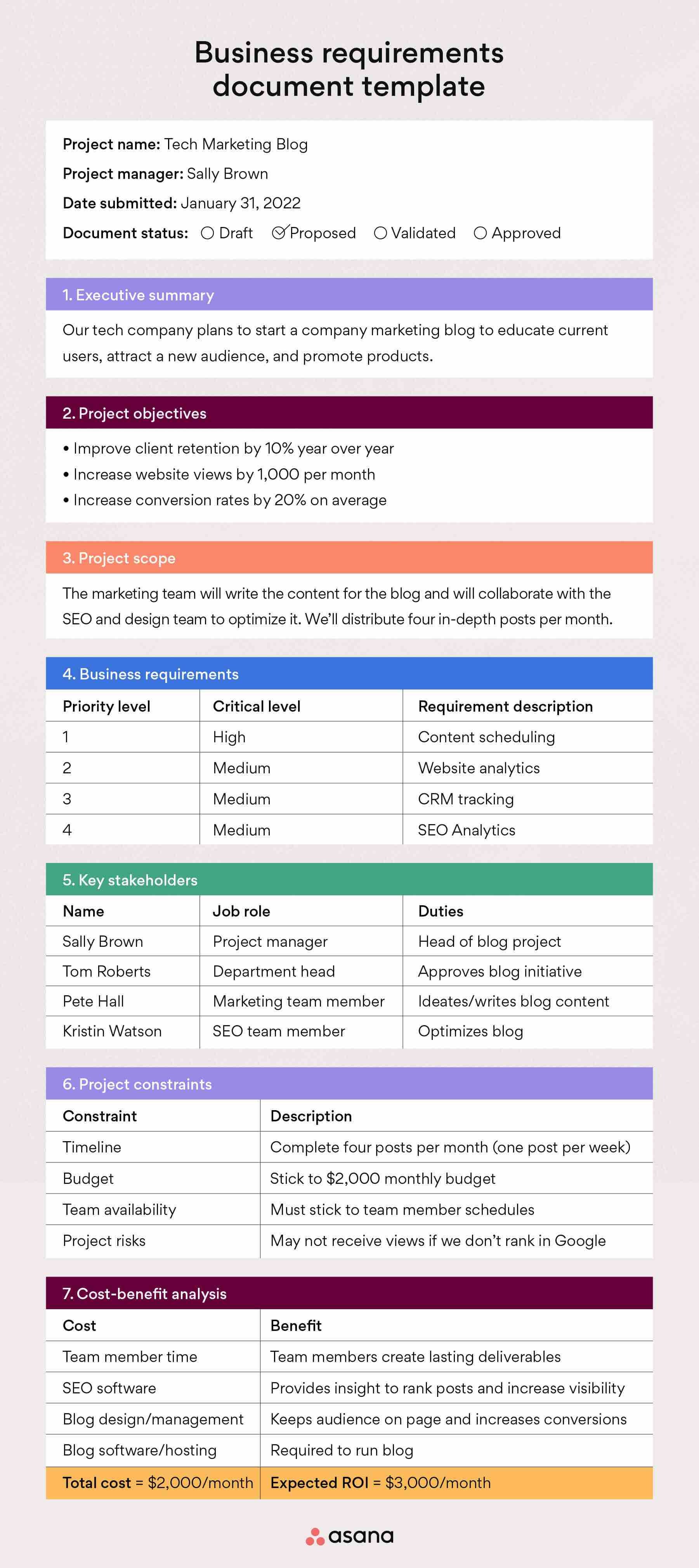Planning to start a new project at your organization? Then, you must document all the requirements properly in order to manage and execute the project successfully. And to help you just that, with this blog, we bring you a complete guide on how to write an excellent business requirements document (BRD). Read more to find out everything you need – from a quick overview to a detailed anatomy, best practices, a free template, and more.
_1280_720.jpg)
Business Requirements Document (BRD): A Quick Overview
To begin, we need to first understand what a Business Requirements Documentation (BRD) is. It is a well-structured, detailed, and formally written document that defines or outlines everything about a particular project taken up by the business or company. In other words, you can also describe it as an overview of the project structure and holds information about the company’s plans, expectations/end goals, key stakeholders, and probable financial budgets, among many other data.
A BRD can also represent a basic contract between the company and other teams outlining the expectations and the deliverables for the project in question. Essentially, this document acts as a guideline for stakeholders to make decisions regarding the project ensuring that the plans align with the expected goals or objectives. And if a change in the plan is required, the requirements document must be revised or updated to reflect the modifications.
The main objective here is to show what the project structure would look like from a business perspective. So, when done correctly, it should be self-explanatory and remove all ambiguity associated – everything will be listed down clearly and in a way that is clear for everyone to understand.
Why Should Every Business Document A Project’s Requirements?

By now, you must have understood that BRDs paint a complete picture of a potentially successful project for a business. They help to bring together all the teams involved to create consensus collaboration. More importantly, they allow you to understand the required budget and the anticipated return on investment (ROI).
Studies have shown that projects that start and maintain updated business requirement projects tend to be more fruitful than ones that do not. Without BRDs, teams involved in the project may fall out of sync during execution and make decisions that do not align. Therefore, BRDs are the perfect tools a company can use to hedge project failures.
And so, if you are planning to take on a project for your business, it is important that you start off with a proper business requirements document, regardless of how big or small the project may be.
Are There Other Types Of Requirement Documents?
While we are focusing on how to write a proper business requirements document in this article, you must keep in mind that there are many other types of requirements documents in project management. And business requirements document is one among them all.
So what other types of requirements documents are there and where does BRD fit in? The list goes as follows:
- Business requirements documents don’t discuss how the solution should be implemented; instead, they define the overall business needs. It is the project’s general framework or plan of the entire project and is decided with the involvement of all the teams.
- User requirements documents are focused on the value that the product or the project provides to users and cover the various goals that they can accomplish from it. Basically, it highlights the use case of the project as seen from the user’s perspective.
- Your business and user requirements are used to create product requirements documents, which go into great depth about how the product, service, or project must function to meet these goals.
Although they might all have the same goal, these terms shouldn’t be used interchangeably. Functional needs become features as the project develops. And every feature should be focused on meeting the user’s needs or requirements while staying within the limitations of the BRDs.
Information That Is Necessary: What Is The Anatomy Of A BRD?
Now that you have a clear understanding of a BRD, let’s focus on what information or data you need to include in the business requirements document for it to be correct. It should capture the following:

-
An Executive Summary:
The Business Requirements Document must begin with an executive summary – information that provides an overview of the organization and what the business is trying to achieve with the project undertaken. These can include the company’s mission with the project as well as the vision and strategies. It can include the roadmap, risks, solutions, and a list of stakeholders as well.
In other words, it will hold a short but very precise summary of the rest of the document. And for best practices, you can write this section of the business requirements documentation after the rest of the content of the document is filled in.
-
Project Objectives & Roadmap:
After summarizing what your business plans to achieve from the project in question, you will need to clearly address the objectives or end result of the project. This will help you to create a concrete roadmap that defines all the steps you will take to reach the end goal and also help all teams to take decisions as required. This section can also include a timeline of expected deadlines and team meetings.
-
Project Scopes:
The project scope, which should specify in-depth what is included in the project and what would cause it to go out of scope, should come next. From this section, everyone should be able to tell which aspects of the project plan will be feasible and which now. This helps to establish a distinct boundary and enables all stakeholders and teams to reach a consensus on the objectives and results of the said project.
-
Key Stakeholders:

Afterward, you’ll want to identify and list the key stakeholders in the project. This will help you assign roles, tasks, and responsibilities for the entire project. This section of BRD helps to keep all the departments involved in the project in sync with all the work that is going around even if teams do not work together.
-
Prioritized Requirements
Then, it is time for you to define which business requirements are the most important and needs to be prioritized. This way you can clearly separate the tasks that will take longer to do or more effort to accomplish, and start working on them earlier than the rest.
-
Project Assumed Constraints
This section of the business requirements document must list all the boundaries of the project. These can include timelines, deadlines, the maximum team member availability, budgets, limitations with the toolkits, and anything else that can constrain the work. And having all these listed down will help teams know what they are working with and how to manage the project best.
-
Budget Plans
As you can already tell, after the constraints, you need to analyze the cost of completing the project and reaching the predicted end goal. When writing the business requirements document, you not only have to write down the total amount that is to be spent but must also include the roadmap milestone or schedule-wise payments that are required.

Starting from onboarding team member cost to operation cost, and any non-essential project costs in-between need to be included in the section of the BRD. You can also include a budget for any unexpected hiccups that might arise during the run of the project. Overall, the budgeting section of the business requirements document should be planned with precision to ensure the project runs smoothly without any interruption in the long run.
-
Cost-Benefit Analysis
And finally, you’ll also want to do a cost-benefit analysis to determine if the costs associated with the project are worth the benefits you’ll get. This is highly important because every member involved in the project should be informed about the information or result of the analysis before diving into it.
There are many other sections of research data that you can include in your project’s business requirements document. This information can vary depending on the type of project your company is planning to work on or the type of organization you run. The more detailed the BRD is, the better it will be for your company to run a successful project.
Best Practices & Tips To Follow When Documenting Business Requirements
There is no doubt that a lot of work and information goes into creating a BRD. However, it need not be. And to help you out further, below we have listed some of the tried and tested best practices and tips you can follow. Use the guidelines below to write your own business requirements document.

1. Start By Learning From Previous Successful Projects
To write the BRD properly, you can start off by reviewing successful past projects completed within the organization and how requirements documentation before starting your own. Then, you can decide what worked well the previous times, what points were missed, and what needs to be done differently for better results this time.
2. Capture Your Requirements Before Jotting Them Down
Next, sit down with other team members to brainstorm the project details, gather all points of requirements, and then note them down formally in a document. This might seem like a lengthy task, but it is very necessary for the success of the BRD.
3. Add Visual Elements To Clarify The Content Properly
Research indicated that the majority of the population learns faster or absorbs information better if visuals are added along with plain texts. Therefore, as best practice to capture the attention of all team members and stakeholders involved, you should add enough graphics, charts, and images.
A Well-Written Business Requirements Document Template
And finally, before we complete this detailed guide on how to write a proper Business Requirements Document (BRD) for an upcoming project, we want to share an excellent example with you. Below, we bring you the business requirements document template by Asana. It is free and can be edited in real-time. Check it out from this link.

Successfully Write A Business Requirements Document
And with that, we want to conclude our complete guide on how to write well-documented business requirements. We hope this blog helps you prepare for your next project easily. If you use the guideline or tips given above, do let us know by commenting below. Subscribe to our blogs for more such helpful guides, tips, and tricks to grow your business, subscribe to our blogs or join our friendly community on Facebook.







